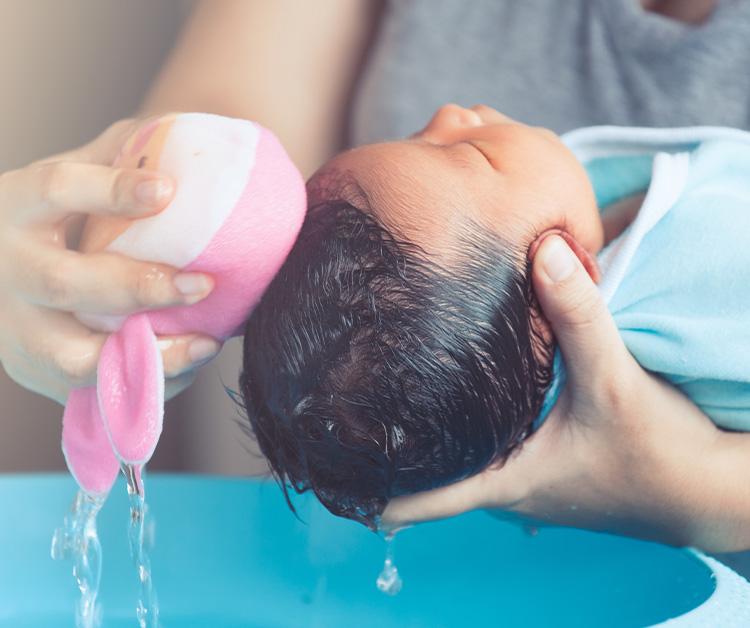No Enfamil products are affected by the recent recall initiated by another manufacturer. Learn more about our quality standards.

How to clean your little one with a gentle sponge or tub bath.
Your baby’s first bath is just one of the sweet milestones you and your little one will experience together. Bathing is not only about cleaning; it’s also a very comforting and soothing time for your newborn. Your baby’s initial baths will be sponge baths, followed by traditional tub bathing.
New parents may feel a little uneasy about bathing their infant, but by following these steps and tips, you’ll be able to bathe your baby safely and enjoy some bonding time as well.
A sponge bath is the preferred bathing method for newborns who still have their umbilical cord stump or baby boys healing from circumcision. Simply use a wet cloth to gently dab and wipe down your baby while they are lying on a plush towel—no need for a tub or sink.
Get your baby ready for their first sponge bath and all the cleanliness and post-bath cuddles that come with it.
You’ll need:
Lay a towel on a flat, comfortable surface or in a baby tub.
Place your baby on the towel and lay them on their back or side. Help them stay warm by covering the areas you’re not bathing with a washcloth, and consider keeping the diaper on for now until you’re ready to clean that area.
Dip the washcloth in the warm water. Test the water to make sure it isn’t too hot. Start with your little one’s face. Gently dab your baby with a washcloth, avoiding their eyes and mouth.
Work your way down the body, dabbing each area with a wet soapy washcloth and drying each area as you go. Be sure to get between the fingers and toes, behind the ears, under the chin, and behind any skin rolls. Take care around the umbilical stump, patting the area dry after cleaning.
Take off the baby’s diaper and use a different washcloth to dab the genitals and bottom.
Use a washcloth with warm water to wipe off any soap.
Dry your baby with a soft towel and put them in a clean diaper. It’s time for snuggles!
Many parents prefer to bathe their baby in a baby tub or the kitchen sink if it’s big enough, but using a clean bathtub also works just fine.
Fill the tub or sink with a couple of inches of water—or about ankle-deep for your baby.
The water should be warm, but not hot. Use your wrist to make sure it feels comfortable, or if you have a thermometer, the water temperature should not be higher than 100 degrees Fahrenheit.
While supporting your baby's head and neck with one arm, use your other hand to slowly lower your baby into the tub, feet first. Make sure their head is supported at all times. Always keep your hands on your baby while bathing them, and never leave your baby unattended.
Clean your little one’s skin with a soft washcloth or sponge, starting with the face and working your way down to their fingers and toes. You can use a small amount of mild baby soap. Avoid getting soap or water in your baby's eyes and ears.
Use a pitcher or cup to gently rinse your baby's skin with clean water, making sure to remove all soap.
Once you're finished, lift your baby out of the tub while supporting their head and neck with one arm.
Carefully pat your baby dry with a soft towel, making sure to dry all the folds of their skin. Dress them in a clean diaper and clothing, and make sure they are warm and dry. It’s cuddle time!
Talk to your pediatrician, but typically you can give your newborn their first sponge bath within a week after birth, but only after 24 hours.
For tub baths, it's recommended to wait until your baby's umbilical cord stump falls off, which is usually around one or two weeks after birth. Until then, sponge baths are the safest way to keep your baby clean. Always reach out to your doctor to find out what’s best for your baby.
As long as you thoroughly clean away spit-up and the diaper area after every change, bathing your little one two or three times a week is usually enough to keep your baby clean. Newborns don’t need daily bathing, as overbathing can dry out their delicate skin and strip their natural oils.
View our video to learn more about bathing a newborn.
Just like feeding time, bathing your newborn is an opportunity to create special moments with your little one. The tender skin-to-skin contact helps give your baby a sense of security while they experience new textures, smells, and the joy of movement. You are learning about each other, having fun, and creating deeper bonds.
For more tips and resources on all things baby, be sure to join Enfamil Family Beginnings®. Enjoy up to $400 in savings, plus exclusive rewards, support, and surprises. Join now.
All information on Enfamil, including but not limited to information about health, medical conditions, and nutrition, is intended for your general knowledge and is not a substitute for a healthcare professional's medical identification, advice, or management for specific medical conditions. You should seek medical care and consult your doctor or pediatrician for any specific health or nutrition issues. Never disregard professional medical advice or delay seeking medical treatment, care, or help because of information you have read on Enfamil.